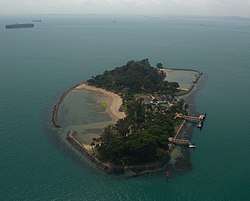Kusu Island
Kusu Island is one of the Southern Islands in Singapore, located about 5.6 kilometres (3.5 miles) to the south of the main island of Singapore and below the Singapore Straits. "Kusu" means "Tortoise Island" or "Turtle Island" in Hokkien; the island is also known as Peak Island or Pulau Tembakul in Malay. It can be taken by a boat from Marina South Pier. The word kusu also means flatulence in Tamil, one of Singapore's official languages—however, this is in no way related to the name of the island, and is a misconception. From two outcrops on a reef, the island was enlarged and transformed into an island of 85,000 square metres (914,932 sq ft).
| Native name: Pulau Tembakul | |
|---|---|
 Aerial perspective of Kusu Island, Singapore. Shot in 2016. | |
.svg.png) Kusu Island Location of Kusu Island within Singapore | |
| Etymology | Tortoise island |
| Geography | |
| Location | Southeast Asia |
| Coordinates | 1°13′22″N 103°51′40″E |
| Archipelago | Malay Archipelago |
| Area | 0.085 km2 (0.033 sq mi) |
| Administration | |
| Region | Central Region |
| Planning Area | Southern Islands |
| Constituency | |
| Member of Parliament |
|
| Demographics | |
| Population | not applicable (not allowed to live there) (2020)[1] |
| Additional information | |
| Official website | Official website |
| Transport Marina South Pier | |
The legend behind the island says that a magical tortoise turned itself into an island to save two shipwrecked sailors, one a Malay and the other a Chinese.
At the top of the rugged hillock on Kusu Island stands three keramats (or holy shrines of Malay saints) to commemorate a pious man (Syed Abdul Rahman), his mother (Nenek Ghalib) and his sister (Puteri Fatimah), all of whom once lived in the 19th century. Many devotees will climb the 152 steps leading up to the kramats to pray for wealth, good marriage, good health and harmony. The shrines are also popular with childless couples who would pray for children. Despite misconceptions, they do not pray to the keramats, but at the sites.
Also located on Kusu island is the popular Chinese temple dedicated to both Da Bo Gong (大伯公), or Tua Pek Kong (Grand Uncle), and Na Tuk Kong (Dato Keramat or "拿督公"). Built in 1923 by a wealthy businessman, the temple houses two main Taoist deities, Da Bo Gong and Guan Yin ("观音", or Goddess of Mercy). The former is highly regarded as having the power to confer prosperity, cure diseases, calm the sea and avert danger, while Guan Yin is known as the "Giver of Sons".
It is popular for its lagoons, pristine beaches and general tranquil settings. Visits are often made by occasional ferry trips from the nearby Marina South Pier (formerly from Clifford Pier) to see the famous wishing well and the Tortoise Sanctuary. Afternoon picnics on the island are also very popular, although no food or beverage service providers are situated on the island. A stand-alone open-air hawker centre is located in the middle of the island but it is only open and running during certain periods of the year, such as during festivals or pilgrimages to the keramats or the temple. No overnight stays are permitted on the island. However, most ferries to Kusu Island also route past Saint John's Island, which does have overnight lodging offered.
References
- "Southern Group (Subzone, Singapore) - Population Statistics, Charts, Map and Location". City Population (with data from the Singapore Department of Statistics). Retrieved 1 January 2020.
- Chia, Jack Meng-Tat. "Managing The Tortoise Island: Tua Pek Kong Temple, Pilgrimage, and Social Change in Pulau Kusu, 1965-2007." New Zealand Journal of Asian Studies 11, 2 (December 2009): 72-95.
- Lu, Caixia. "The Kusu Pilgrimage: An Enduring Myth." International Institute for Asian Studies Newsletter 59 (Spring 2012): 50-51.
External links
| Wikimedia Commons has media related to Kusu Island. |
- Satellite image of Peak Island - Google Maps
- Info for visitors on wildsingapore
- Kusu Island Coral Reef Survey Data on Coral Reefs of Singapore